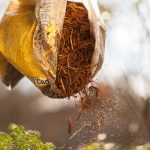Grass burs typically take root in late winter, but in Texas they can sprout several times a year. The trick is to suppress them before the seeds germinate.
Sticker bur, aka grass bur or field sandbur, is one of the most hated weeds in our lawns. Most commonly found on disturbed or sandy soil, Cenchrus spinifex may show up just about anywhere where disturbance has occurred.
This is typically a grassy, warm season (germinates in late winter) weed, but in Texas grass burs may germinate in late winter, early spring, mid-spring and late summer.
All weeds begin with seeds so suppression of grass burs begins before and after seeds germinate.
Before
Pre-emergent herbicides are frequently prescribed to prevent bur seeds from germinating. They must be used in February and again in April because burs may germinate at different points in the season.
A natural method is the application of corn meal gluten on top of the lawn. The most common application rate is 20 pounds per 1000 square feet. Generally a ¼ inch would be about right. Corn meal alone is used as a fungicide.
Sandburs are extremely adverse to healthy thick strands of turf so practice the Best Management Practices for a good lawn: water infrequently but deeply, fertilize in late spring and fall with products rich in nitrogen and humates, and above all, mow frequently.
After
The best method to prevent and control grass burs is to mow frequently and consistently. All weeds cannot tolerate mowing, which encourages grass and weakens weeds. Later in June and July when seeds develop on any remaining plants, catch clippings and dispose of them properly.
My favorite method of long term management is dragging a large piece of old carpeting behind a mower or tractor. This will catch a lot of seed and reduce next year’s crop, particularly if children and dogs tag along for a ride on the carpet.
Post-emergent herbicides include the old selective standards such as 2,4-D and dicamba and the non-selective glyphosate. A natural, non-selective method is a combination of orange oil, strong vinegar and dishwashing soap. The formulation is 2 ounces orange oil, 1 gallon strong vinegar (18 percent or higher) and ½ to 1 ounce of dishwashing soap.
Suppression of grass burs requires constant surveillance and decisive action, but a mostly weed-free landscape can be achieved if you are willing to address the problem before and after.




